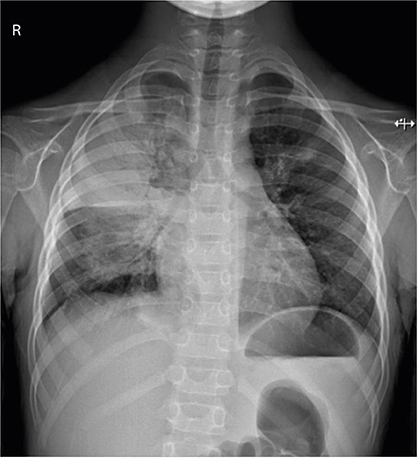Pediatr Infect Vaccine.
2019 Aug;26(2):118-123. 10.14776/piv.2019.26.e14.
Postinfectious Glomerulonephritis Associated with Pneumococcus and Influenza A Virus Infection in a Child: a Case Report and Literature Review
- Affiliations
-
- 1Department of Pediatrics, Seoul National University Children's Hospital, Seoul, the Republic of Korea. pedwilly@snu.ac.kr
- 2Department of Pediatrics, Seoul National University College of Medicine, Seoul, the Republic of Korea.
- 3Department of Pediatrics, Chungbuk National University Hospital, Cheongju, the Republic of Korea.
- KMID: 2455530
- DOI: http://doi.org/10.14776/piv.2019.26.e14
Abstract
- Postinfectious glomerulonephritis (PIGN) is most commonly caused by Streptococcus pyogenes in children, but PIGN associated with other pathogens has been described in the literature. A previously healthy 6-year-old boy was admitted with complaints of cough, fever, and right chest pain. The patient was diagnosed with pneumococcal bacteremia and influenza A virus infection and treated with antibiotics and antiviral agent. During hospitalization, generalized edema, hematuria, proteinuria, and increased blood pressure were observed; therefore, we started administering diuretics. The boy was discharged with gross hematuria, and even microscopic hematuria disappeared 14 weeks after discharge. We report a case of PIGN associated with bacteremic pneumococcal pneumonia and influenza A virus infection in children. A urine test and blood pressure measurement should be considered for the early detection of PIGN in children with pneumococcal or influenza A virus infection when they present with nephritic symptoms.
MeSH Terms
Figure
Reference
-
1. Eison TM, Ault BH, Jones DP, Chesney RW, Wyatt RJ. Post-streptococcal acute glomerulonephritis in children: clinical features and pathogenesis. Pediatr Nephrol. 2011; 26:165–180.
Article2. Hyman LR, Jenis EH, Hill GS, Zimmerman SW, Burkholder PM. Alternative C3 pathway activiation in pneumococcal glomerulonephritis. Am J Med. 1975; 58:810–814.3. Odaka J, Kanai T, Ito T, Saito T, Aoyagi J, Betsui H, et al. A case of post-pneumococcal acute glomerulonephritis with glomerular depositions of nephritis-associated plasmin receptor. CEN Case Rep. 2015; 4:112–116.
Article4. Carceller Lechón F, de la Torre Espí M, Porto Abal R, Écija Peiró JL. Acute glomerulonephritis associated with pneumonia: a review of three cases. Pediatr Nephrol. 2010; 25:161–164.
Article5. Schachter J, Pomeranz A, Berger I, Wolach B. Acute glomerulonephritis secondary to lobar pneumonia. Int J Pediatr Nephrol. 1987; 8:211–214.6. Wolach B, Uziel Y, Berger I, Pomeranz A. Cat-scratch bacillus and Streptococcus pneumoniae causing submandibular suppurative adenitis and acute glomerulonephritis. Child Nephrol Urol. 1990; 10:158–160.7. Phillips J, Palmer A, Baliga R. Glomerulonephritis associated with acute pneumococcal pneumonia: a case report. Pediatr Nephrol. 2005; 20:1494–1495.
Article8. Hibino S, Hoshino A, Fujii T, Abe Y, Watanabe S, Uemura O, et al. Post-streptococcal acute glomerulonephritis associated with pneumococcal infection. Pediatr Int. 2013; 55:e136–e138.
Article9. Ismail IH, Zainudin Z, Othman N. Pneumococcal glomerulonephritis in a healthy child: a case report and literature review. Singapore Med J. 2014; 55:e69–e72.
Article10. Kaehny WD, Ozawa T, Schwarz MI, Stanford RE, Kohler PF, McIntosh RM. Acute nephritis and pulmonary alveolitis following pneumococcal pneumonia. Arch Intern Med. 1978; 138:806–808.
Article11. Gunasekaran K, Krishnamurthy S, Mahadevan S, Harish BN, Kumar AP. Clinical characteristics and outcome of post-infectious glomerulonephritis in children in southern India: a prospective study. Indian J Pediatr. 2015; 82:896–903.
Article12. Srivastava T, Warady BA, Alon US. Pneumonia-associated acute glomerulonephritis. Clin Nephrol. 2002; 57:175–182.
Article13. Laso MC, Cadario ME, Haymes L, Grimoldi I, Balbarrey Z, Casanueva E. Mycoplasma pneumoniae detection with PCR in renal tissue of a patient with acute glomerulonephritis. Pediatr Nephrol. 2006; 21:1483–1486.
Article14. Jain T, Hemington L, Etuwewe B. A case of post-infectious glomerulonephritis following infection with influenza A subtype H1N1. Pediatr Nephrol. 2011; 26:151–152.
Article
- Full Text Links
- Actions
-
Cited
- CITED
-
- Close
- Share
- Similar articles
-
- Benign Acute Childhood Myositis Associated with Influenza B Virus
- A Case of Severe Influenza Infection in a Child with Nephrotic Syndrome on Steroid Therapy
- Atypical Kawasaki Disease Presenting as Acute Kidney Injury in a Patient with Influenza B Virus Infection
- Steroid Effect for Persistent Cough Developed after 2009 Pandemic Influenza A (H1N1) Infection: 5 Cases
- Adult immunization


